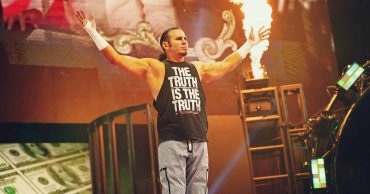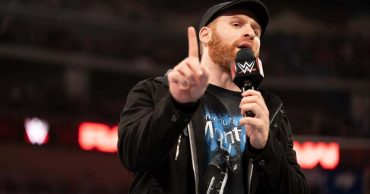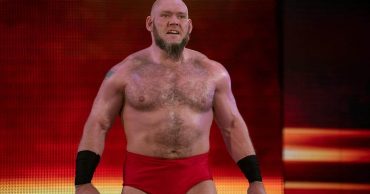World Wrestling Entertainment. Just those three words alone conjure up images of mayhem and madness, splendor and spectacle, anticipation and anguish. For anyone coming of age in the eighties, they also meant one thing: must-see television. Since its inception in 1985, WWE’s WrestleMania broadcast has helped teenage boys live out their dreams of demolition while simultaneously giving female fans both swoon-worthy heroes and powerful females to look up to.
Yet, the storied past of WWE is too comprehensive to lump it all into a comprehensive category of “televised wrestling.” Rather, true WWE fans define the broadcast by its ebbs and flows, or the shifts through which it came into our lives. Take the “Attitude Era” for example. By the last half of the 1990s, the WWE was then known as the World Wrestling Foundation, or WWF. On Monday nights, fans would gather around their screens as “WWF Monday Night Raw” would air, competing against “Monday Nitro,” which was broadcasted by World Championship Wrestling (WCW).
Despite who won the ratings war, this era gave rise to some of our most prolific and memorable WWF wrestlers to date, including Stone Cold Steve Austin and The Rock. While WCW held its own with celebrities including The Big Show, Chris Benoit and The Big Show, these headliners would eventually make their way over to top dog WWF, cementing it as an iconic part of television history.
Though ratings peaked in 1999 and have been on a steady decline since, die-hard fans have stayed true. Most will also tell you that, before the Attitude Era there was the Golden Era, the time period from 1982-1993 in which the WWF debuted some of its most beloved and timeless stars, chief among them Hulk Hogan, Jesse “The Body” Ventura and Ricky “The Dragon” Steamboat. These performers laid the groundwork for the boom that occurred in the Attitude Era and set off a nationwide frenzy that helped propel the sport from a niche industry into a household name.
For old time’s sake, let’s take a look at where a few of our Golden Era WWF wrestlers are now and the mark they all left on America’s real pastime.
1. The Honky Tonk Man
He looked like Elvis but was built like Goliath. He was dressed as The King in every way, down to his tassels and slicked-back black hair and though the schtick was sometimes cringe-worthy, audiences ate it up like Halloween candy. Though many will argue that The Honky Tonk Man (real name: Roy Lee Farris) is one of the reasons that this era is also called “The Cartoon Era” for its impersonations and gimmicks, he embodied the fun and flair of the sport like no one before him. He was also mega-talented, still holding the record for the longest Intercontinental Championship reign, coming in at a staggering 454 days.
Now, you can find The Honky Tonk Man on the road, performing on his “Shake, Rattle and Roll” comedy tour for audiences all across the country. During his act, he delivers never-before-heard details about the WWE and the professional wrestling business as a whole.
2. Jesse “The Body” Ventura
A solid, successful professional wrestler before the WWE broadcast even became a weeknight mainstay, Ventura (real name: James George Janos) was also a noted and respected commentator on the sport. Beside fellow broadcaster Gorilla Monsoon, he lent his voice, opinion and feedback on some of the greatest matches of the era, including most of the fights that comprised the original WrestleMania shows. As such, when today’s wrestling fans think back on watching the sport as a kid, most of their memories are colored by Ventura’s unmistakable voice blaring through the loudspeakers.
In 2004, Ventura was inducted into the WWE Hall of Fame, yet before that, he continued to make a name for himself, only this time as a politician and sometimes-movie star, appearing in the film “Predator” alongside Arnold Schwarzenegger in 1987.
From 1993 to 2003, he served as the governor of Minnesota and even teased a potential run for president in 2016. Though he reportedly escaped to Mexico in 2014, going off the grid to avoid being found by drones, today, his iconic voice can still be heard through the airways, this time on his reality show titled “The World According to Jesse,” broadcast on the Russia Today America. The political show is described as a blend of journalistic reporting and opinion-based commentary on myriad hot-topic issues and current affairs.
3. Jake “The Snake” Roberts
He was the master of striking terror and anticipation in his opponents. From the way he grabbed the mike to playfully taunt his arrival to the very much alive snake he brought with him into the ring, arguably no other wrestler during the WWE Golden Era knew how to make an entrance quite like Jake “The Snake” Roberts (real name: Aurelian Jake Smith, Jr.). Yet, though the mustached mega-star put up a tough front, life outside of the ring has taken a toll on the former pro wrestler.
After 37 years of wrestling, Roberts reported to Rolling Stone in 2017 that the many concussions he’d sustained during his time at WWE had left him with a few “spots on his brain” that could make it difficult to complete sentences or remember certain details from the past.
Along with a pair of cancer scares, these physical issues were compounded by his struggle with addiction, which was first divulged in the 1999 documentary “Beyond The Mat.” The story came full-circle, however, culminating with 2015’s eye-opener “The Resurrection of Jake the Snake.” Through therapy, yoga, and mentors (most notably WCW mainstay “Diamond Dallas Page), Roberts appears to once again be on the upswing, inducted into the WWE Hall of Fame in 2014.
4. Hulk Hogan
Just the name alone is enough to bring a smile of remembrance to devoted wrestling fans around the world. Known just as much for his trademark blonde mustache and deeply tanned muscles as the swag and confidence he brought to the ring, Hulk Hogan (real name: Terry Gene Bollea) was at the epicenter of the WWE Golden Era, leading the pack for the scores of celebrity fighters who would follow. For a majority of the era, he reigned supreme as the WWE Champion and took center stage for most of the WrestleMania events.
As such, it didn’t take long for the alliterative moniker to become a household name. He continued to wrestle professionally on a frequent basis until the late 2000s, when he decided to give reality television a shot, premiering “Hogan Knows Best” in 2005 which led to the 2008 spin-off “Brooke Knows Best,” centered around his daughter, Brooke.
From video games to roles in several television series and movies, Hogan has continued to make a name for himself in the decade since leaving televised wrestling, even opening an e-commerce platform showcasing gloriously retro wrestling t-shirts, belts, toys and autographed souvenirs for the nostalgic at heart. This month, he’s set to appear at the 2 Sweet: nWo Reunion, which marks the first time in 22 years that the original three nWo (New World Order) members will be back together again, with Scott Hall and Kevin Nash joining the ranks.
5. Sgt. Slaughter
Though his career peaked toward the final years of the WWE Golden Era, St. Slaughter (real name: Robert Remus) still made a name for himself at the end, most notably due to his in-ring feud with fellow wrestler Hulk Hogan. Though he won the WWE Championship, Hogan would quickly regain his top spot, defeating Slaughter at WrestleMania VII in 1991. Slaughter, along with many other wrestlers from this time, was inducted into the WWE Hall of Fame in 2004.
He also continues to be a part of the WWE, appearing in 2014 in an episode of “Raw,” wherein he went up against United States Champion Rusev. He also works in an ambassador capacity for the organization, helping out with charity-based endeavors such as those sponsored through the Make-a-Wish Foundation.
Why We Watched and Why It Lives On
So, there you have it! While critics will argue the sport is a little campy, in an era during which there was (and continues to be) so much political and social unrest, televised wrestling gave us a chance to release our frustrations, channel our competitive energies and root victoriously for our favorite fighter. These five standouts from the Golden Era continue to be modern-day celebrities if for nothing else, their contributions to this unyielding platform. When we wanted to speak out but couldn’t find the words, Hogan declared it for us.
When we wanted to challenge authority, stare down our opponent and claim victory, we did so through the actions of Ventura, Slaughter, Roberts and the Honky Tonk Man himself. Their roles in the WWE might have shifted and they may no longer be hopping into the rings to lay down some serious body slams, but they’ve crashed through history and claimed the title of visionaries, nonetheless.
 Follow Us
Follow Us





